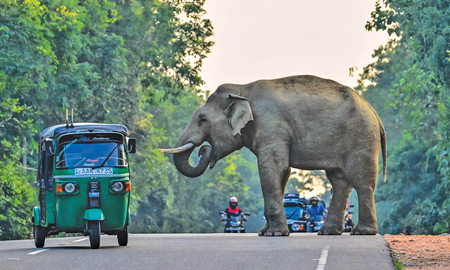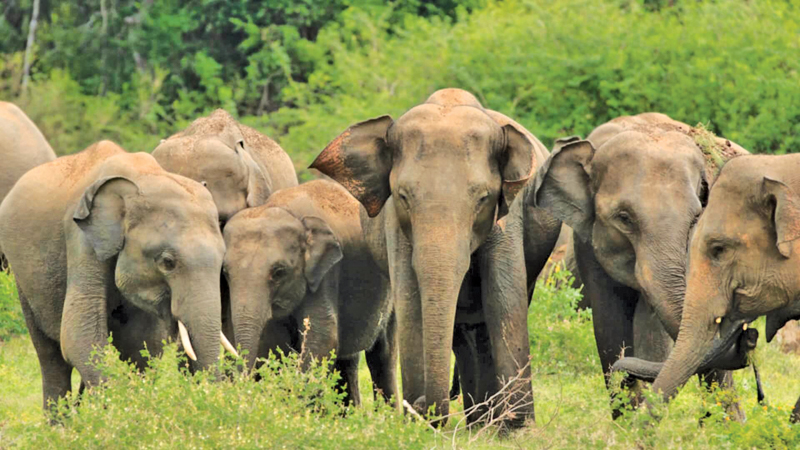Sri Lanka remains one of the last strongholds for the endangered Asian elephant. The island nation hosts the largest concentration of free-ranging elephants anywhere in Asia. With the footprint and intensity of human activity increasing, a Human-Elephant Conflict (HEC) is prevalent and threatens the well-being of people and elephants.
Through a diverse range of activities, the Association of Zoos and Aquariums’ SAFE: Saving Animals From Extinction (Asian elephant) project seeks to support sustainable strategies to alleviate conflict with Asian elephants across their entire range. However, the ever-changing nature of the conflict makes it particularly challenging to address and location-specific approaches to mitigating conflict are necessary to promote human-elephant coexistence. Oftentimes, a lack of information—including local perspectives on the challenges and priorities associated with conservation—prevent action at smaller geographic scales.
Perceptions towards elephants
The Oklahoma City Zoo in Oklahoma City, Okla., founded The Sri Lanka Elephant Project (SLEP) in 2023 as a data-driven initiative to provide targeted information to stakeholders in Central and North-Central Sri Lanka who live and work among elephants in the region. Animal-centred research at SLEP includes ongoing monitoring of elephant demographics, behaviour, and various metrics of health, including stress biomarkers and gut microbiota.
We use social science to measure attitudes and perceptions towards elephants and other wildlife among local community members. The interdisciplinary and inclusive nature of our research is particularly effective as we seek to develop a holistic understanding of how elephants respond to human activity and how local communities engage with wildlife.
 Extending from SLEP’s scientific directive is our mission to build capacity for elephant conservation in the region. We accomplish this in part by ensuring all our activities are non-extractive and instead build mutually beneficial collaborations. These relationships are based upon local skills and experiences, and they are enhanced by existing technical expertise from the SLEP’s team in the field and at the Zoo.
Extending from SLEP’s scientific directive is our mission to build capacity for elephant conservation in the region. We accomplish this in part by ensuring all our activities are non-extractive and instead build mutually beneficial collaborations. These relationships are based upon local skills and experiences, and they are enhanced by existing technical expertise from the SLEP’s team in the field and at the Zoo.
The SLEP’s operations are headquartered in a field house in a village that experiences frequent conflict with elephants, and our field team comprises Sri Lankan postgraduate students who act as paid research assistants and are mentored as emerging conservationists. Zoo staff from diverse teams—including conservation and science, information technology, animal care, and marketing—collaborate with the field team to bolster research and outreach efforts.
The core of SLEP’s elephant research focuses on the long-term monitoring of elephants that can be observed in the Minneriya and Kaudulla National Parks about 25 km from our field house. These parks are home to the largest annual elephant gathering in Asia. At certain times of the year, hundreds of elephants congregate around a large water source in the park, giving us an unparalleled opportunity to understand dynamic social processes that are otherwise obscured when elephants are under dense tree cover in the adjacent forests. The parks are highly popular among wildlife tourists, and farmlands around the parks are conflict hotspots.
Therefore, by getting to know individual elephants in these parks, we learn about how and why elephants in this region traverse varied landscapes to congregate here in large numbers. Through non-invasive research, we may better understand the impacts of human activity—both tourism and agriculture—on elephant health and well-being.
The SLEP’s field team has a near daily presence in the parks, diligently recording all elephant sightings. The Research Assistants use each elephant’s combination of physical features, such as ear shapes, scar patterns, and tail hair length, to distinguish individual animals from each other. Each elephant we can reliably identify is assigned a distinct identification number and or name.
An elephant’s features may change over their lifetime, so the field team keeps a photographic record of each elephant in our growing database, which comprises almost 300 sub-adult and adult elephants at the time of writing. The process can be slow and painstaking, even with elephants that are established in the database.
When our research efforts were still developing, we constructed photographic guides that consisted of many pages that researchers could scroll through on their smartphones as they attempted to identify elephants in the field, on the relatively rare occurrence they could not recognise an elephant on sight.
More recently and with multiple field seasons, it became apparent that we required a technology solution that could assist us to quickly and accurately identify any one of hundreds of elephants in our database.
Any solution we implemented would also need to be field-friendly in hot, humid environments without much technological infrastructure. With these challenges in mind, we tapped into the resources and expertise at the Oklahoma City Zoo to develop a customised solution.
The Zoo’s Senior Director of Information Technology, Matthew Word, built an app utilising Microsoft’s PowerApps as the front-end interface coupled with Microsoft Dataverse as the underlying database.
This helps the SLEP field team to take the app offline on an Apple iPad Pro to view, edit, and upload data in the field where connectivity to cloud systems is limited. Once the team can return to the field house after their research, they push data updates back to the cloud where the database is housed.
This app incorporates some “off the shelf” templates within Microsoft PowerApps but has had custom coding to add in specific options for searching and viewing records within the application.
Elephant social dynamics
Zoo staff met the SLEP field team in Sri Lanka in May 2024 to test the app in real-world conditions. This was imperative for the successful implementation of the app, for the staff from the US to better understand limitations in the field. Since then, the app has been successfully implemented into SLEP’s routine data collection practices, and the field team can quickly and effectively identify elephants during field visits, with the ability to quickly adjust the parameters and entries of the database when required. With the ability to follow individual elephants throughout their lives, we can leverage long-term datasets to understand elephant social dynamics and the impact that environmental changes (including human pressures) have on animal health and wellbeing.
Apart from the elephant identification app, technology also enables collaboration between SLEP team members in the U.S. and Sri Lanka. Implementing Microsoft Office 365 for the SLEP team members has streamlined communication and collaboration by utilising Microsoft SharePoint for data and image storage and sharing and Microsoft Teams for communicating.
Zoos can contribute specialised expertise and resources to global research and conservation projects. AZA SAFE serves as a model that prioritises collective action and commitment in a way that is strategic and measurable. As a case in point, the SLEP is a collaborative effort whose success depends upon engaging partners with distinct and varied experiences and interests. Our ability to provide stakeholders with useful tools is driven by scientific research and inspired by technological advancements that allow for efficient data collection in real-time.
The threats to Asian elephants across all range countries are numerous and complex and require site-specific approaches that tailor conservation to the elephants and human communities. Moreover, technology helps us to move beyond numbers and statistics to put individual elephants at the center of conservation.
Dr. Chase LaDue is a conservation scientist at the Oklahoma City Zoo and Botanical Garden.






